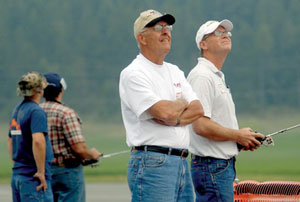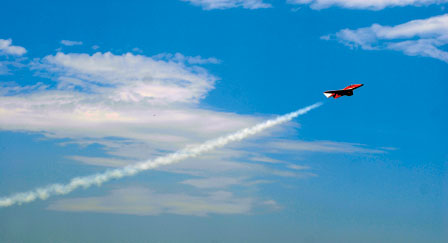Model airplanes, for some, are quite a bit more than wood, wings and glue. They are turbines and combustion chambers, fiberglass and landing gear, high soars and low dives – and the occasional crash at 200 miles per hour.
They are jets, in fact. And for a father and son, they are the pinnacles of lifetimes devoted to model airplanes.
“With these jets,” Addison Clark Jr. said, “you can still fly airplanes and pretend you’re a big-time pilot.”
The thing is, Addison Jr. and Sr. are big-time pilots, as were most of the 20 or so participants at last weekend’s second annual Mountain Thunder Radio Control (RC) Jet Rally held outside of Whitefish. The rally wasn’t a competition, but more of a gathering of RC fanatics from around the nation. Nor was it a light-hearted collection of little propeller projects. It was a serious display of how far the model plane world has come.
Many of the men behind the handheld radio control sets were professional pilots who have found a way to carry their love of flying into their personal lives. For a living, they fly commercial 747 passenger planes, F-14 fighter jets, helicopters and whatever else scoots through the air. Addison Sr., the event coordinator, is a retired Navy pilot. Addison Jr. is a helicopter pilot for Kalispell’s ALERT air ambulance.
The Clarks are two of five gas turbine-certified RC jet pilots in Montana, which means they passed the complicated review process to gain a waiver – and $2 million liability insurance – to fly RC jets with a gas turbine engine, instead of an electric or piston powered fan. These jets, which have human-sized wing spans, sound and fly like real jets.
 |
|
Bruce Tharpe, right, pilots a BTE – Bruce Tharpe Engineering – radio control model aircraft with help from his spotter, Bob Brusa, at the Mountain Thunder Radio Control Jet Rally. – Lido Vizzutti |
“They get up and go,” Addison Sr. said.
The rally is in its second year. Participants can thank the efforts of the Glacier RC’ers club and the generosity of Duane and Kathleen Carlson for the impressive 800-foot runway, which was built over a four-year period. Not only did the Carlsons provide their property for the runway, they also donated between $17,000 and $20,000 in gravel and materials, Addison Sr. said. Before building their runway on the Carlsons’ property, the RC’ers flew their jets at Glacier International Airport.
Gary Layos, who has attended many other rallies, said the runway is top of the line.
“It’s a beautiful, beautiful runway,” he said.
Layos isn’t a trained pilot and said he has learned to fly the powerful model jets the hard way – self-teaching with inevitable crashes.
“(At first) it was pretty wild,” he said, describing the details of wrecks. “Ninety-percent of the time, the (jets) are destroyed. I’ve had my share of crashes.”
A basic Almost-Ready-To-Fly jet, which comes completed and painted but without all the internal parts, costs $3,600, Layos said. Nicer “scale birds”– scale model jets that are designed precisely like full-size jets – run up to $25,000. Scale birds have more advanced features, like retractable landing gear, than the sporty smaller jets, but are not usually as fast. Those initial costs don’t factor in years of repairs and jet fuel expenses.
Pilots spent the week before the rally preparing, tinkering and practicing. Before flight, a pilot inspects every detail of the jet. A tiny misalignment of anything, from something in the fuel injection system to the wiring, could mean the pilot has to find a new jet. Each pilot needs to have a strong understanding of mechanics.
Addison Jr. began building model planes when he was 13. His father gave him his own table so father and son could work side by side in the shop, each with his own creation area. The boy’s hobby grew throughout high school, taking up more time and money, until it evolved into something tangible.
“It led into a career for me,” he said, referring to his careers in the Air Force and later for the ALERT air ambulance.
The jets are capable of flying up to 250 miles per hour or more, though pilots try to keep them below 200, Addison Sr. said. They can fly upwards of 1,000 feet in altitude, but usually stay between 200 and 400 feet, with periodic dives close to the ground. Fire extinguishers are abundant in case of a fiery wreck or mechanical malfunction.
Addison Jr. said that “in Montana we’re not in the jet culture,” compared to places in the Northeast, South and California. But somebody who has a genuine infatuation with model planes, his father said, has one advantage in Montana to nurture such a passion: plenty of time in the shop.
“Montana has long winters,” he said.
